2006 CHEVROLET EQUINOX seat adjustment
[x] Cancel search: seat adjustmentPage 7 of 382
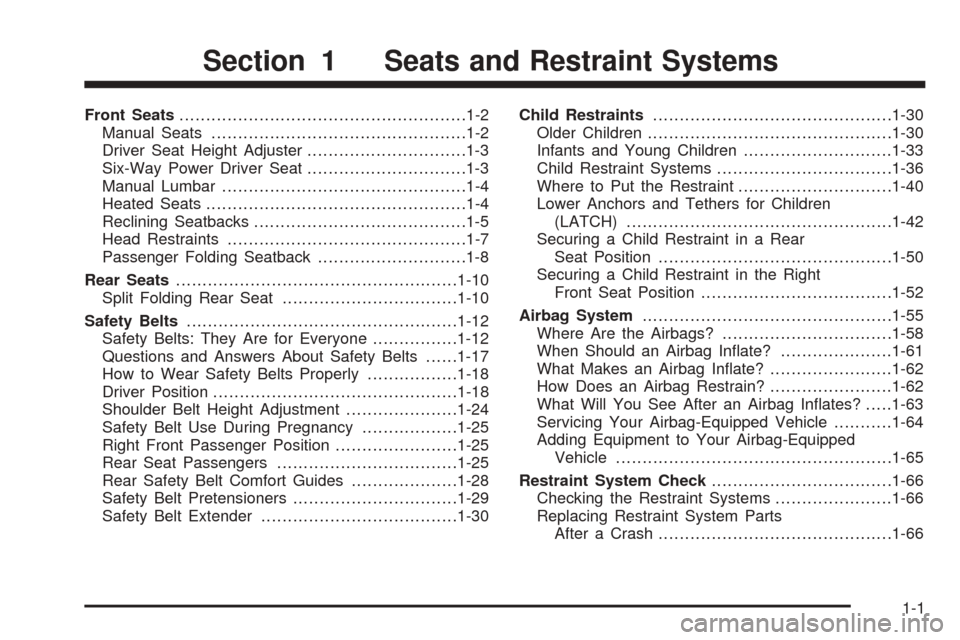
Front Seats......................................................1-2
Manual Seats................................................1-2
Driver Seat Height Adjuster..............................1-3
Six-Way Power Driver Seat..............................1-3
Manual Lumbar..............................................1-4
Heated Seats.................................................1-4
Reclining Seatbacks........................................1-5
Head Restraints.............................................1-7
Passenger Folding Seatback............................1-8
Rear Seats.....................................................1-10
Split Folding Rear Seat.................................1-10
Safety Belts...................................................1-12
Safety Belts: They Are for Everyone................1-12
Questions and Answers About Safety Belts......1-17
How to Wear Safety Belts Properly.................1-18
Driver Position..............................................1-18
Shoulder Belt Height Adjustment.....................1-24
Safety Belt Use During Pregnancy..................1-25
Right Front Passenger Position.......................1-25
Rear Seat Passengers..................................1-25
Rear Safety Belt Comfort Guides....................1-28
Safety Belt Pretensioners...............................1-29
Safety Belt Extender.....................................1-30Child Restraints.............................................1-30
Older Children..............................................1-30
Infants and Young Children............................1-33
Child Restraint Systems.................................1-36
Where to Put the Restraint.............................1-40
Lower Anchors and Tethers for Children
(LATCH)..................................................1-42
Securing a Child Restraint in a Rear
Seat Position............................................1-50
Securing a Child Restraint in the Right
Front Seat Position....................................1-52
Airbag System...............................................1-55
Where Are the Airbags?................................1-58
When Should an Airbag In�ate?.....................1-61
What Makes an Airbag In�ate?.......................1-62
How Does an Airbag Restrain?.......................1-62
What Will You See After an Airbag In�ates?.....1-63
Servicing Your Airbag-Equipped Vehicle...........1-64
Adding Equipment to Your Airbag-Equipped
Vehicle....................................................1-65
Restraint System Check..................................1-66
Checking the Restraint Systems......................1-66
Replacing Restraint System Parts
After a Crash............................................1-66
Section 1 Seats and Restraint Systems
1-1
Page 121 of 382
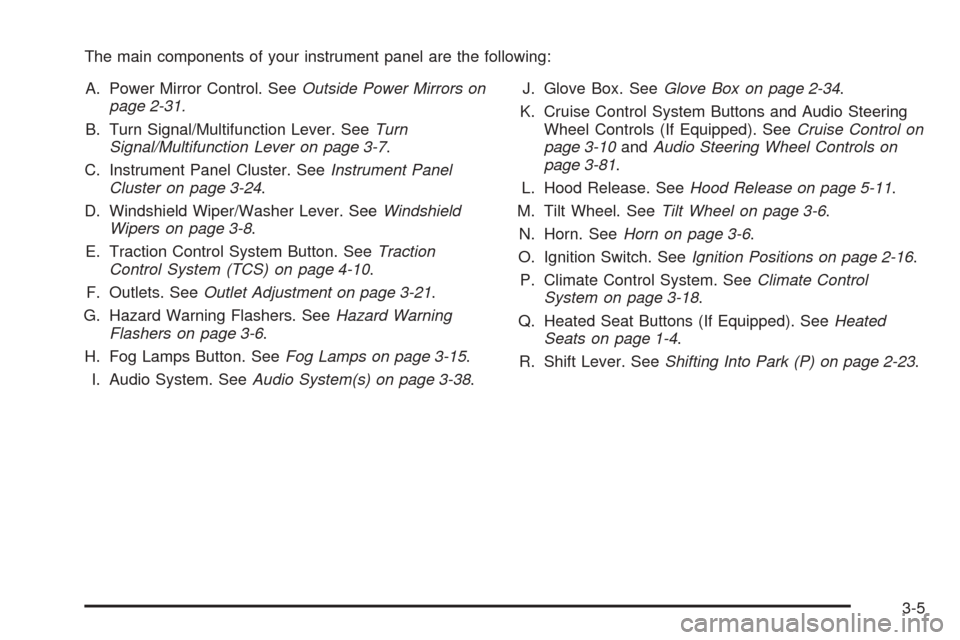
The main components of your instrument panel are the following:
A. Power Mirror Control. SeeOutside Power Mirrors on
page 2-31.
B. Turn Signal/Multifunction Lever. SeeTurn
Signal/Multifunction Lever on page 3-7.
C. Instrument Panel Cluster. SeeInstrument Panel
Cluster on page 3-24.
D. Windshield Wiper/Washer Lever. SeeWindshield
Wipers on page 3-8.
E. Traction Control System Button. SeeTraction
Control System (TCS) on page 4-10.
F. Outlets. SeeOutlet Adjustment on page 3-21.
G. Hazard Warning Flashers. SeeHazard Warning
Flashers on page 3-6.
H. Fog Lamps Button. SeeFog Lamps on page 3-15.
I. Audio System. SeeAudio System(s) on page 3-38.J. Glove Box. SeeGlove Box on page 2-34.
K. Cruise Control System Buttons and Audio Steering
Wheel Controls (If Equipped). SeeCruise Control on
page 3-10andAudio Steering Wheel Controls on
page 3-81.
L. Hood Release. SeeHood Release on page 5-11.
M. Tilt Wheel. SeeTilt Wheel on page 3-6.
N. Horn. SeeHorn on page 3-6.
O. Ignition Switch. SeeIgnition Positions on page 2-16.
P. Climate Control System. SeeClimate Control
System on page 3-18.
Q. Heated Seat Buttons (If Equipped). SeeHeated
Seats on page 1-4.
R. Shift Lever. SeeShifting Into Park (P) on page 2-23.
3-5
Page 137 of 382
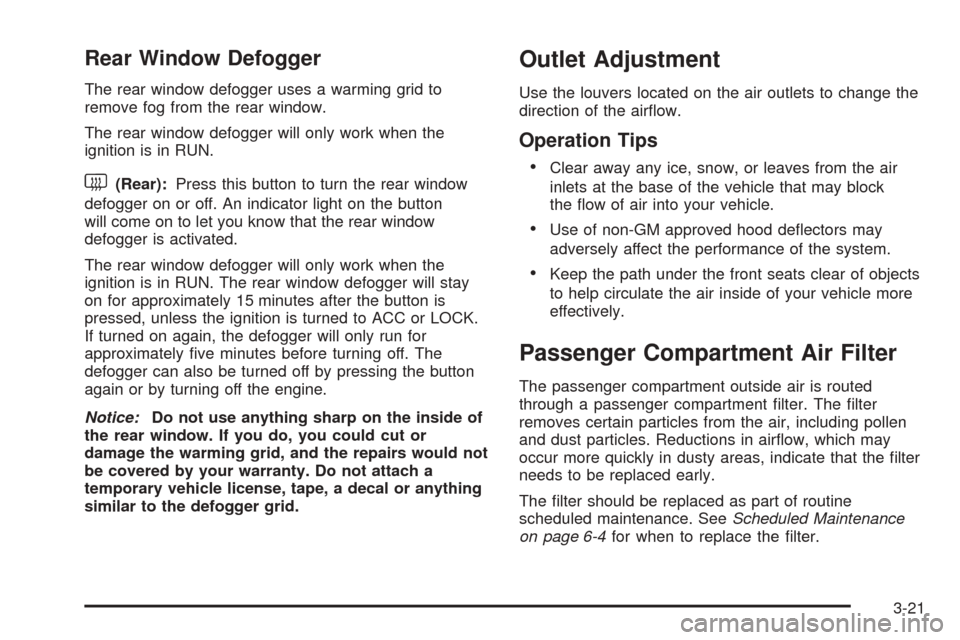
Rear Window Defogger
The rear window defogger uses a warming grid to
remove fog from the rear window.
The rear window defogger will only work when the
ignition is in RUN.
<(Rear):Press this button to turn the rear window
defogger on or off. An indicator light on the button
will come on to let you know that the rear window
defogger is activated.
The rear window defogger will only work when the
ignition is in RUN. The rear window defogger will stay
on for approximately 15 minutes after the button is
pressed, unless the ignition is turned to ACC or LOCK.
If turned on again, the defogger will only run for
approximately �ve minutes before turning off. The
defogger can also be turned off by pressing the button
again or by turning off the engine.
Notice:Do not use anything sharp on the inside of
the rear window. If you do, you could cut or
damage the warming grid, and the repairs would not
be covered by your warranty. Do not attach a
temporary vehicle license, tape, a decal or anything
similar to the defogger grid.
Outlet Adjustment
Use the louvers located on the air outlets to change the
direction of the air�ow.
Operation Tips
Clear away any ice, snow, or leaves from the air
inlets at the base of the vehicle that may block
the �ow of air into your vehicle.
Use of non-GM approved hood de�ectors may
adversely affect the performance of the system.
Keep the path under the front seats clear of objects
to help circulate the air inside of your vehicle more
effectively.
Passenger Compartment Air Filter
The passenger compartment outside air is routed
through a passenger compartment �lter. The �lter
removes certain particles from the air, including pollen
and dust particles. Reductions in air�ow, which may
occur more quickly in dusty areas, indicate that the �lter
needs to be replaced early.
The �lter should be replaced as part of routine
scheduled maintenance. SeeScheduled Maintenance
on page 6-4for when to replace the �lter.
3-21
Page 343 of 382
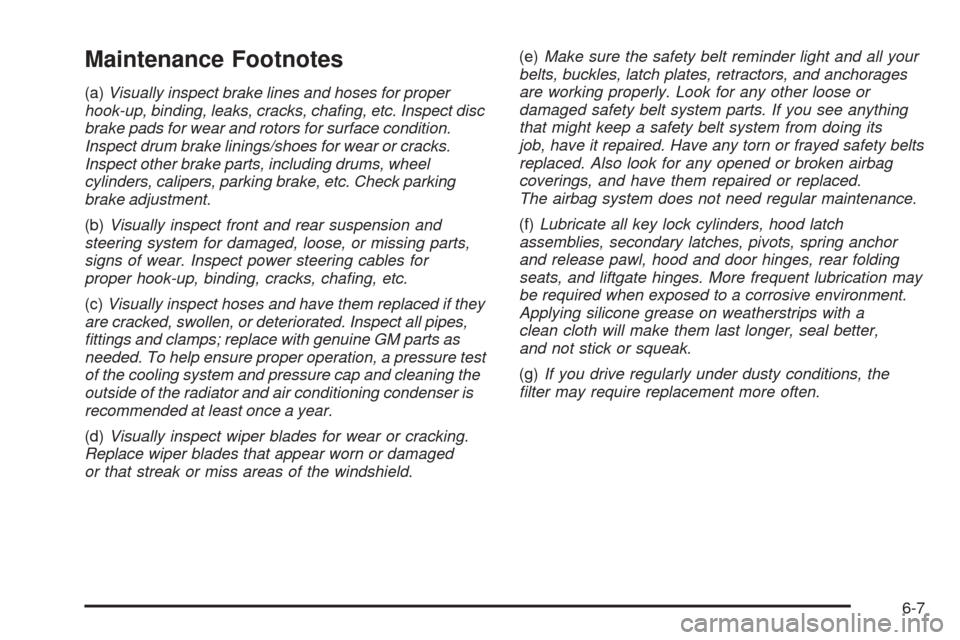
Maintenance Footnotes
(a)Visually inspect brake lines and hoses for proper
hook-up, binding, leaks, cracks, cha�ng, etc. Inspect disc
brake pads for wear and rotors for surface condition.
Inspect drum brake linings/shoes for wear or cracks.
Inspect other brake parts, including drums, wheel
cylinders, calipers, parking brake, etc. Check parking
brake adjustment.
(b)Visually inspect front and rear suspension and
steering system for damaged, loose, or missing parts,
signs of wear. Inspect power steering cables for
proper hook-up, binding, cracks, cha�ng, etc.
(c)Visually inspect hoses and have them replaced if they
are cracked, swollen, or deteriorated. Inspect all pipes,
�ttings and clamps; replace with genuine GM parts as
needed. To help ensure proper operation, a pressure test
of the cooling system and pressure cap and cleaning the
outside of the radiator and air conditioning condenser is
recommended at least once a year.
(d)Visually inspect wiper blades for wear or cracking.
Replace wiper blades that appear worn or damaged
or that streak or miss areas of the windshield.(e)Make sure the safety belt reminder light and all your
belts, buckles, latch plates, retractors, and anchorages
are working properly. Look for any other loose or
damaged safety belt system parts. If you see anything
that might keep a safety belt system from doing its
job, have it repaired. Have any torn or frayed safety belts
replaced. Also look for any opened or broken airbag
coverings, and have them repaired or replaced.
The airbag system does not need regular maintenance.
(f)Lubricate all key lock cylinders, hood latch
assemblies, secondary latches, pivots, spring anchor
and release pawl, hood and door hinges, rear folding
seats, and liftgate hinges. More frequent lubrication may
be required when exposed to a corrosive environment.
Applying silicone grease on weatherstrips with a
clean cloth will make them last longer, seal better,
and not stick or squeak.
(g)If you drive regularly under dusty conditions, the
�lter may require replacement more often.
6-7
Page 376 of 382
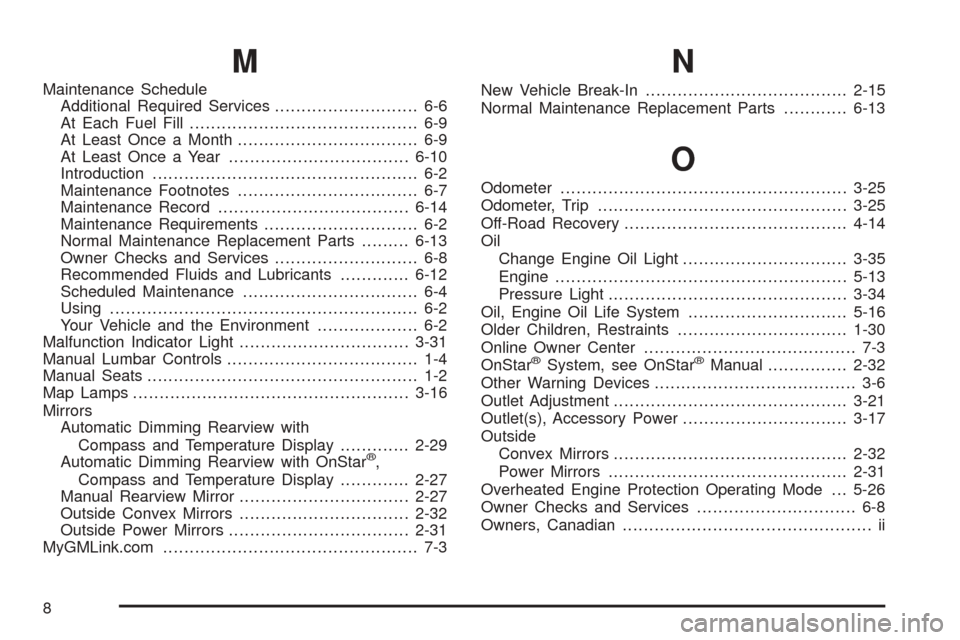
M
Maintenance Schedule
Additional Required Services........................... 6-6
At Each Fuel Fill........................................... 6-9
At Least Once a Month.................................. 6-9
At Least Once a Year..................................6-10
Introduction.................................................. 6-2
Maintenance Footnotes.................................. 6-7
Maintenance Record....................................6-14
Maintenance Requirements............................. 6-2
Normal Maintenance Replacement Parts.........6-13
Owner Checks and Services........................... 6-8
Recommended Fluids and Lubricants.............6-12
Scheduled Maintenance................................. 6-4
Using.......................................................... 6-2
Your Vehicle and the Environment................... 6-2
Malfunction Indicator Light................................3-31
Manual Lumbar Controls.................................... 1-4
Manual Seats................................................... 1-2
Map Lamps....................................................3-16
Mirrors
Automatic Dimming Rearview with
Compass and Temperature Display.............2-29
Automatic Dimming Rearview with OnStar
®,
Compass and Temperature Display.............2-27
Manual Rearview Mirror................................2-27
Outside Convex Mirrors................................2-32
Outside Power Mirrors..................................2-31
MyGMLink.com................................................ 7-3
N
New Vehicle Break-In......................................2-15
Normal Maintenance Replacement Parts............6-13
O
Odometer......................................................3-25
Odometer, Trip...............................................3-25
Off-Road Recovery..........................................4-14
Oil
Change Engine Oil Light...............................3-35
Engine.......................................................5-13
Pressure Light.............................................3-34
Oil, Engine Oil Life System..............................5-16
Older Children, Restraints................................1-30
Online Owner Center........................................ 7-3
OnStar
®System, see OnStar®Manual...............2-32
Other Warning Devices...................................... 3-6
Outlet Adjustment............................................3-21
Outlet(s), Accessory Power...............................3-17
Outside
Convex Mirrors............................................2-32
Power Mirrors.............................................2-31
Overheated Engine Protection Operating Mode . . . 5-26
Owner Checks and Services.............................. 6-8
Owners, Canadian............................................... ii
8